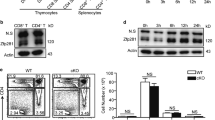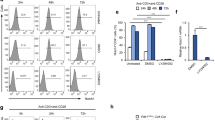Abstract
Stimulation of the T cell receptor (TCR) complex initiates multiple signaling cascades that lead to the activation of several transcription factors, including the NF-κB family members. Although various proximal signaling components of the TCR have been intensively studied, the distal components that mediate TCR-induced NF-κB activation remain largely unknown. Using a somatic mutagenesis approach, we cloned a CARMA1-deficient T cell line. Deficiency in CARMA1 (originally known as CARDII) resulted in selectively impaired activation of NF-κB induced by the TCR and a consequent defect in interleukin-2 (IL-2) production. Reconstitution of the CARMA1-deficient cells with CARMA1 fully rescued this signaling defect. Together, our results show that CARMA1 is an essential signaling component that mediates TCR-induced NF-κB activation.
This is a preview of subscription content, access via your institution
Access options
Subscribe to this journal
Receive 12 print issues and online access
$209.00 per year
only $17.42 per issue
Buy this article
- Purchase on Springer Link
- Instant access to full article PDF
Prices may be subject to local taxes which are calculated during checkout







Similar content being viewed by others
References
Weiss, A. & Littman, D.R. Signal transduction by lymphocyte antigen receptors. Cell 76, 263–274 (1994).
Clements, J.L., Boerth, N.J., Lee, J.R. & Koretzky, G.A. Integration of T cell receptor-dependent signaling pathways by adapter proteins. Annu. Rev. Immunol. 17, 89–108 (1999).
Zhang, W. & Samelson, L.E. The role of membrane-associated adaptors in T cell receptor signalling. Semin. Immunol. 12, 35–41 (2000).
Rudd, C.E. Adaptors and molecular scaffolds in immune cell signaling. Cell 96, 5–8 (1999).
Baldwin, A.J. The NF-κB and IκB proteins: new discoveries and insights. Annu. Rev. Immunol. 14, 649–683 (1996)
Ghosh, S., May, M.J. & Kopp, E.B. NF-κB and Rel proteins: evolutionarily conserved mediators of immune responses. Annu. Rev. Immunol. 16, 225–260 (1998).
Verma, I.M., Stevenson, J.K., Schwarz, E.M., Van, A.D. & Miyamoto, S. Rel/NF-κB/IκB family: intimate tales of association and dissociation. Genes Dev. 9, 2723–2735 (1995).
Karin, M. & Ben-Neriah, Y. Phosphorylation meets ubiquitination: the control of NF-κB activity. Annu. Rev. Immunol. 18, 621–663 (2000).
Chambers, C.A. & Allison, J.P. Costimulatory regulation of T cell function. Curr. Opin. Cell Biol. 11, 203–210 (1999).
Monks, C.R., Kupfer, H., Tamir, I., Barlow, A. & Kupfer, A. Selective modulation of protein kinase C-θ during T-cell activation. Nature 385, 83–86 (1997).
Coudronniere, N., Villalba, M., Englund, N. & Altman, A. NF-κB activation induced by T cell receptor/CD28 costimulation is mediated by protein kinase C-θ. Proc. Natl. Acad. Sci. USA 97, 3394–3399 (2000).
Lin, X., O'Mahony, A., Mu, Y., Geleziunas, R. & Greene, W.C. Protein kinase C-θ participates in NF-κB activation induced by CD3-CD28 costimulation through selective activation of IκB kinase β. Mol. Cell. Biol. 20, 2933–2940 (2000).
Sun, Z. et al. PKC-θ is required for TCR-induced NF-κB activation in mature but not immature T lymphocytes. Nature 404, 402–407 (2000).
Bi, K. et al. Antigen-induced translocation of PKC-θ to membrane rafts is required for T cell activation. Nature Immunol. 2, 556–563 (2001).
Koseki, T. et al. CIPER, a novel NF-κB-activating protein containing a caspase recruitment domain with homology to Herpesvirus-2 protein E10. J. Biol. Chem. 274, 9955–9961 (1999).
Srinivasula, S. et al. CLAP, a novel caspase recruitment domain-containing protein in the tumor necrosis factor receptor pathway, regulates NF-κB activation and apoptosis. J. Biol. Chem. 274, 17946–17954 (1999).
Thome, M. et al. Equine herpesvirus-2 E10 gene product, but not its cellular homologue, activates NF-κB transcription factor and c-Jun N-terminal kinase. J. Biol. Chem. 274, 9962–9968 (1999).
Willis, T.G. et al. Bcl10 is involved in t(1;14)(p22;q32) of MALT B cell lymphoma and mutated in multiple tumor types. Cell 96, 35–45 (1999).
Yan, M., Lee, J., Schilbach, S., Goddard, A. & Dixit, V. mE10, a novel caspase recruitment domain-containing proapoptotic molecule. J. Biol. Chem. 274, 10287–10292 (1999).
Zhang, Q. et al. Inactivating mutations and overexpression of BCL10, a caspase recruitment domain-containing gene, in MALT lymphoma with t(1;14)(p22;q32). Nature Genet. 22, 63–68 (1999).
Ruland, J. et al. Bcl10 is a positive regulator of antigen receptor-induced activation of NF-κB and neural tube closure. Cell 104, 33–42 (2001).
Bertin, J. et al. CARD9 is a novel caspase recruitment domain-containing protein that interacts with BCL10/CLAP and activates NF-κB. J. Biol. Chem. 275, 41082–41086 (2000).
Bertin, J. et al. CARD11 and CARD14 are novel caspase recruitment domain (CARD)/membrane-associated guanylate kinase (MAGUK) family members that interact with BCL10 and activate NF-κB. J. Biol. Chem. 276, 11877–11882 (2001).
Gaide, O. et al. Carma1, a CARD-containing binding partner of Bcl10, induces Bcl10 phosphorylation and NF-κB activation. FEBS Lett. 496, 121–127 (2001).
McAllister-Lucas, L. et al. Bimp1, a MAGUK family member linking protein kinase C activation to Bcl10-mediated NF-κB induction. J. Biol. Chem. 276, 30589–30597 (2001).
Wang, L. et al. Card10 is a novel caspase recruitment domain/membrane-associated guanylate kinase family member that interacts with BCL10 and activates NF-κB. J. Biol. Chem. 276, 21405–21409 (2001).
Dimitratos, S.D., Woods, D.F., Stathakis, D.G. & Bryant, P.J. Signaling pathways are focused at specialized regions of the plasma membrane by scaffolding proteins of the MAGUK family. BioEssays 21, 912–921 (1999).
McKendry, R. et al. High-frequency mutagenesis of human cells and characterization of a mutant unresponsive to both α and γ interferons. Proc. Natl. Acad. Sci. USA 88, 11455–11459 (1991).
Ting, A.T., Pimentel, M.F. & Seed, B. RIP mediates tumor necrosis factor receptor 1 activation of NF-κB but not Fas/APO-1-initiated apoptosis. EMBO J. 15, 6189–6196 (1996).
Lucas, P.C. et al. Bcl10 and MALT1, independent targets of chromosomal translocation in malt lymphoma, cooperate in a novel NF-κB signaling pathway. J. Biol. Chem. 276, 19012–19019 (2001).
Uren, A.G. et al. Identification of paracaspases and metacaspases: two ancient families of caspase-like proteins, one of which plays a key role in MALT lymphoma. Mol. Cell 6, 961–967 (2000).
De Smaele, E. et al. Induction of GADD45β by NF-κB downregulates pro-apoptotic JNK signaling. Nature 414, 308–313 (2001).
Tang, G. et al. Inhibition of JNK activation through NF-κB target genes. Nature 414, 313–317 (2001).
Acknowledgements
We thank V. Dixit, W. Greene, S.-C. Sun, J. Tschop, M. Yan and A. Weiss for reagents; M. Lindermann and S. Gaffen for help in the HT-2 cell proliferation assays; and J. Hay and S. Gaffen for critical reading of this manuscript.
Author information
Authors and Affiliations
Corresponding author
Ethics declarations
Competing interests
The authors declare no competing financial interests.
Rights and permissions
About this article
Cite this article
Wang, D., You, Y., Case, S. et al. A requirement for CARMA1 in TCR-induced NF-κB activation. Nat Immunol 3, 830–835 (2002). https://doi.org/10.1038/ni824
Received:
Accepted:
Published:
Issue Date:
DOI: https://doi.org/10.1038/ni824
This article is cited by
-
Inherited Human BCL10 Deficiencies
Journal of Clinical Immunology (2024)
-
FYN–TRAF3IP2 induces NF-κB signaling-driven peripheral T-cell lymphoma
Nature Cancer (2021)
-
Engineering primary T cells with chimeric antigen receptors for rewired responses to soluble ligands
Nature Protocols (2020)
-
CARD–BCL-10–MALT1 signalling in protective and pathological immunity
Nature Reviews Immunology (2019)
-
Bcl10-controlled Malt1 paracaspase activity is key for the immune suppressive function of regulatory T cells
Nature Communications (2019)



